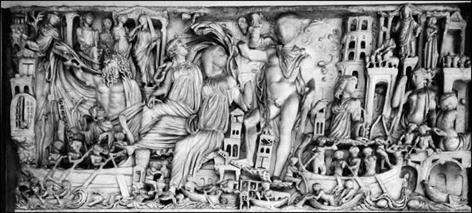Mediterranean ports in the Roman period
Under the Republic, the Roman provinces were resources to be exploited for the sole benefit of Italy. Later on, the emperors came to understand that the cohesion of the Empire depended on the prosperity of the provinces. As the 2nd and 3rd centuries of our
era unfolded, the economic situation of the provinces flourished; a number of them offi-
79
cially declared their wish that “the Roman domination should last eternally.” Maritime navigation is the most effective link among these provinces, and also the most economical. Transport ships plow the Mediterranean Sea, the mare nostrum of the Romans, at least during the warm season – from September to May navigation is officially forbidden on the mare closum. In reality, the navigation period is between March and November. The largest merchant ships are those that transport wheat, routinely displacing 200 of our modern tons and measuring 25 m in length – some attain 60 m.
Merchandise circulates widely – from the granaries of Numedia (present-day [283]
|
Figure 6.35 Harbor scene on a Roman sarcophagus (photo by the author) |
Tunisia), Sicily, and Egypt[284] [285] toward the large Italian cities to be fed; from the regions of oil production, such as Tripolitania, the south of Spain, the north of Syria; from Greece whose wine is highly valued, and also from the regions of Bordeaux (Burdigala), Tarragona (Tarraco), and the south of Gaul, already renowned for their wine. Some of the goods come from far away, like silk from China, spices from southeast Asia, and incense from Arabia. Under the Empire, merchants based at Alexandria or Antioch forge the first direct relations with China of the Han Dynasty.
All of this merchandise attracts pirates, the restive adventurers of the pax romana, often spawned by the upheavals that accompany the progressive annexation of the Orient. Piracy in the Mediterranean is reduced somewhat after the naval victory of Pompeii, and it is eradicated at the beginning of the Christian era, an achievement of Augustus and his son-in-law Agrippa. The Roman military fleet had its beginnings in the Punic wars (3rd century BC). Subsequently, the Empire maintains a military fleet whose squadrons are based at Miseno (near Pouzzuoli, in the Gulf of Naples); at Ravenna, on the Adriatic in the northwest of Italy; and at Alexandria.







Leave a reply